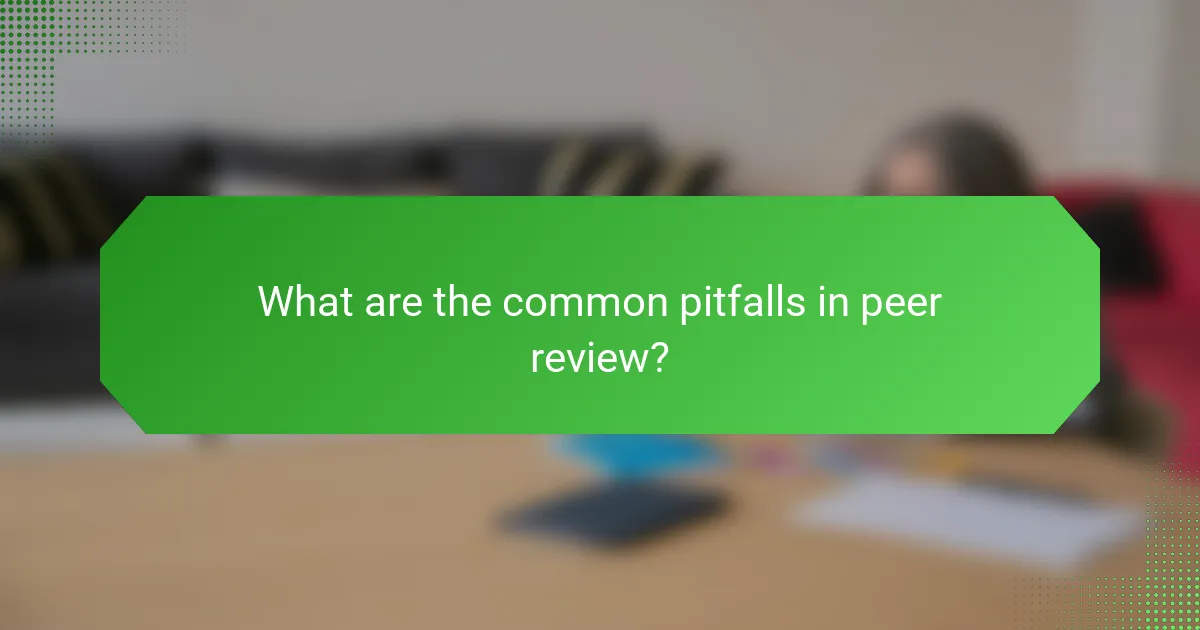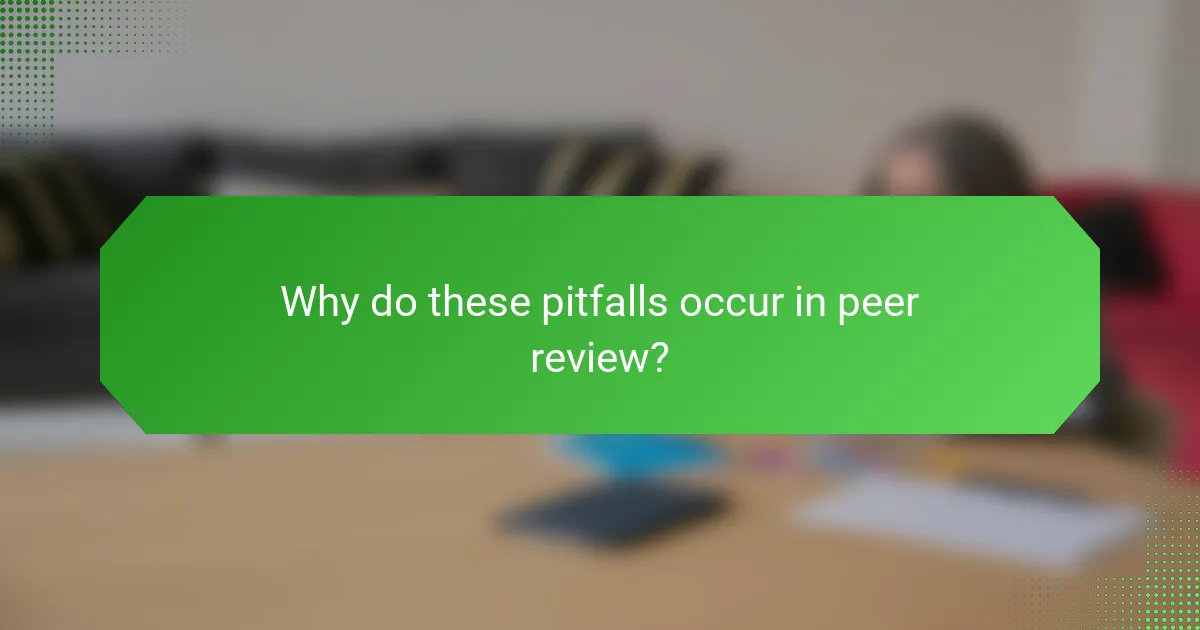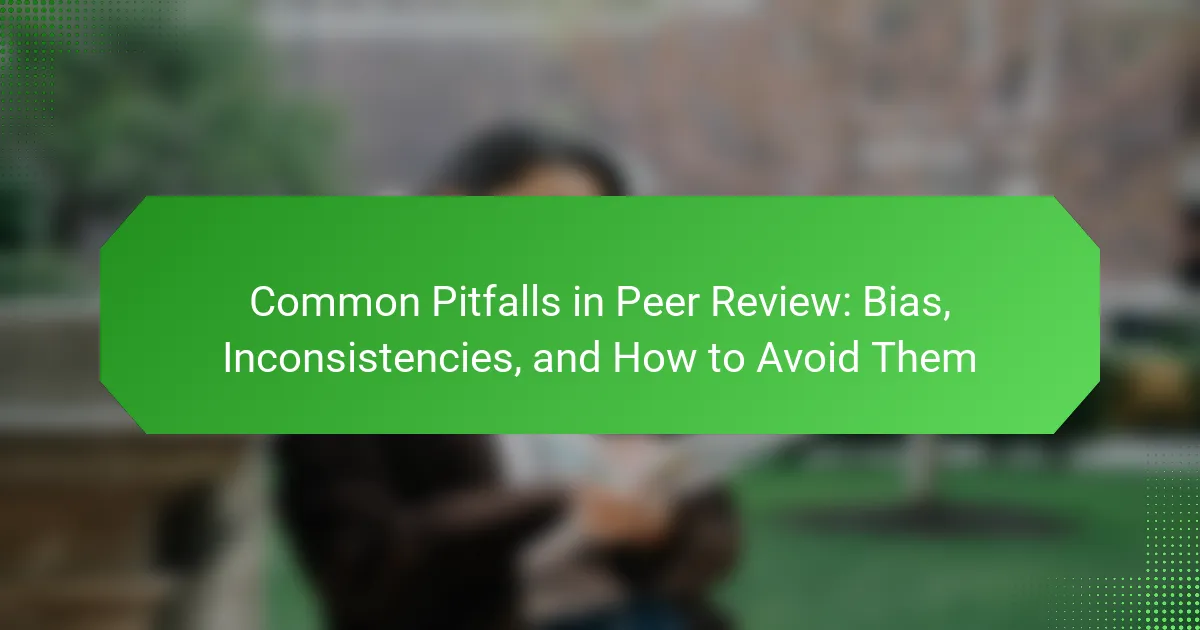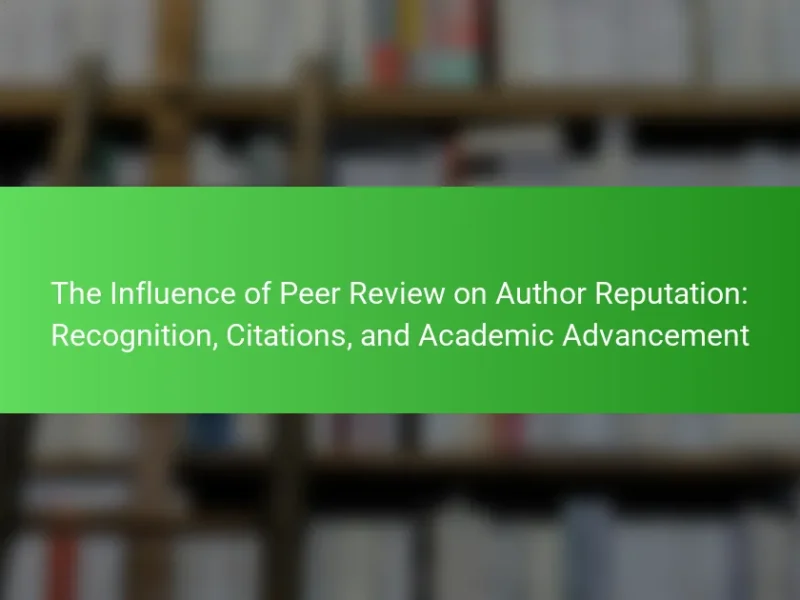The article examines common pitfalls in the peer review process, focusing on bias, lack of thoroughness, and inconsistent standards. Bias can arise from personal affiliations or preferences, leading to unfair evaluations of research quality. Inadequate engagement with materials may result in missed errors, while varying criteria among reviewers can create disparities. The article also highlights the importance of structured guidelines, transparency, and diverse perspectives to mitigate these issues. By fostering open communication and accepting constructive criticism, researchers can enhance the quality of their submissions and improve the integrity of the peer review process.

What are the common pitfalls in peer review?
Common pitfalls in peer review include bias, lack of thoroughness, and inconsistent standards. Bias can manifest as favoritism towards certain authors or institutions. This can lead to unfair evaluations of research quality. Lack of thoroughness occurs when reviewers do not fully engage with the material. This can result in missed errors or oversights. Inconsistent standards arise when reviewers apply different criteria to similar submissions. This can create disparities in the review process. Additionally, insufficient feedback can hinder authors’ ability to improve their work. These pitfalls can undermine the integrity of the peer review process.
How does bias impact the peer review process?
Bias negatively impacts the peer review process by influencing the evaluation of research quality. Reviewers may favor studies that align with their own beliefs or affiliations. This can lead to unfair assessments and potential rejection of valid research. A study published in the journal “Nature” found that biases based on gender, race, and institutional affiliation affect reviewer decisions. Furthermore, biased feedback can discourage authors and skew the published literature. Ultimately, bias undermines the integrity and reliability of scientific communication.
What types of bias are most prevalent in peer reviews?
The most prevalent types of bias in peer reviews include confirmation bias, gender bias, and publication bias. Confirmation bias occurs when reviewers favor studies that support their own beliefs. Gender bias manifests in the unequal treatment of male and female authors, often disadvantaging women. Publication bias refers to the tendency to favor positive results over negative or inconclusive findings. Research indicates that these biases can significantly affect the integrity of the peer review process. A study by Budden et al. (2008) found that female authors face higher rejection rates compared to their male counterparts. Understanding these biases is crucial for improving peer review fairness and quality.
How can bias skew the evaluation of research quality?
Bias can significantly skew the evaluation of research quality by influencing reviewers’ judgments. Reviewers may favor studies that align with their own beliefs or experiences. This can lead to an unfair assessment of the research’s validity and reliability. For example, confirmation bias may cause reviewers to overlook flaws in studies that support their views. Conversely, they might unduly criticize work that contradicts their opinions. Studies show that biases can affect peer review outcomes, leading to inconsistencies in published research. A meta-analysis indicated that biased evaluations can reduce the overall quality of scientific literature. Thus, bias impairs the objectivity essential for accurate research assessment.
What inconsistencies are often found in peer reviews?
Inconsistencies in peer reviews often include variations in reviewer feedback. Reviewers may provide conflicting opinions on the same manuscript. This can lead to confusion regarding the manuscript’s quality. Additionally, the criteria for evaluation may differ among reviewers. Some may prioritize methodology, while others focus on originality. This lack of standardization can result in disparate conclusions. Furthermore, reviewers might overlook critical aspects of the research. This oversight can lead to incomplete assessments. Studies have shown that these inconsistencies can affect publication outcomes significantly.
How do inconsistencies affect the reliability of peer-reviewed research?
Inconsistencies significantly undermine the reliability of peer-reviewed research. They can arise from methodological flaws, data discrepancies, or conflicting interpretations. Such inconsistencies lead to questions about the validity of findings. For instance, if different studies report varying results on the same hypothesis, it creates uncertainty. This uncertainty can misguide further research and practical applications. A review by Ioannidis (2005) highlights that many published findings are not reproducible due to inconsistencies. Thus, addressing inconsistencies is crucial for maintaining the integrity of scientific literature.
What are the common causes of inconsistencies in evaluations?
Common causes of inconsistencies in evaluations include subjective bias, lack of clear criteria, and evaluator fatigue. Subjective bias occurs when personal opinions influence judgments. This can lead to different evaluations for similar work. Lack of clear criteria results in varying interpretations of what constitutes quality. Evaluators may prioritize different aspects of the work. Evaluator fatigue can diminish focus and attention to detail over time. Research shows that fatigue can negatively impact decision-making accuracy. These factors collectively contribute to unreliable evaluations in peer review.

Why do these pitfalls occur in peer review?
Pitfalls in peer review occur due to various biases and inconsistencies. Reviewer bias can stem from personal beliefs, affiliations, or preferences. Inconsistent evaluation criteria can lead to differing standards among reviewers. Lack of transparency in the review process may result in subjective judgments. Additionally, time constraints can pressure reviewers to rush their evaluations. A study by Lee et al. (2013) found that 40% of reviewers admitted to biases affecting their assessments. Such factors collectively contribute to the prevalence of pitfalls in peer review.
What are the underlying factors contributing to bias?
Bias is influenced by various underlying factors. Cognitive biases, such as confirmation bias, lead reviewers to favor information that supports their pre-existing beliefs. Social influences, including peer pressure and groupthink, can also skew objectivity in evaluations. Emotional responses to the subject matter may affect judgment and lead to biased assessments. Cultural background plays a role, as differing values and norms can shape perspectives on research. Additionally, lack of diversity among reviewers can result in homogeneous viewpoints, further perpetuating bias. Research indicates that these factors collectively undermine the integrity of peer review processes.
How do personal beliefs and experiences influence reviewer judgments?
Personal beliefs and experiences significantly influence reviewer judgments. Reviewers often bring their own biases, shaped by cultural, educational, and personal experiences, into the evaluation process. These biases can affect their interpretation of the work’s quality and relevance. For instance, a reviewer with a strong belief in a particular methodology may favor studies that align with that approach. Conversely, negative past experiences with a certain topic may lead to harsher critiques of related submissions. Research shows that cognitive biases, such as confirmation bias, can further skew judgments by leading reviewers to favor information that supports their pre-existing beliefs. This phenomenon can ultimately impact the fairness and objectivity of the peer review process.
What role does the publication process play in fostering bias?
The publication process can significantly foster bias through selective reporting and peer review dynamics. Selective reporting occurs when authors choose to publish only favorable results, leading to a skewed representation of research. Peer review can introduce bias when reviewers favor certain methodologies, perspectives, or authors, impacting the acceptance of manuscripts.
Additionally, the influence of journal impact factors may lead to bias in publication decisions, as high-impact journals often prioritize trendy or novel topics. Research has shown that biases in peer review can result from personal relationships or conflicts of interest among reviewers. A study by Lee et al. (2013) in “PLOS ONE” highlighted that biased peer review can affect the quality and integrity of published research. These factors collectively contribute to a biased publication landscape, affecting the reliability of scientific literature.
In what ways do inconsistencies arise during peer review?
Inconsistencies during peer review arise from subjective interpretations of research quality. Reviewers may have different standards for evaluating studies. Varying levels of expertise can lead to inconsistent feedback. Personal biases may influence the assessment of a manuscript. Discrepancies in the understanding of methodologies can cause confusion. Differences in cultural perspectives may affect the interpretation of results. Lack of clear guidelines can lead to varied expectations among reviewers. These factors contribute to the overall inconsistency in the peer review process.
How can varying expertise among reviewers lead to inconsistencies?
Varying expertise among reviewers can lead to inconsistencies in evaluations. Reviewers with different backgrounds may interpret data and methodologies differently. For example, a reviewer with a strong statistical background may focus on data analysis. In contrast, a reviewer with clinical expertise may prioritize practical applications. This divergence can result in conflicting feedback and recommendations. A study by Lee et al. (2020) in “Research Integrity and Peer Review” highlights that inconsistencies arise when reviewers lack shared knowledge. Additionally, varying levels of familiarity with the subject matter can impact the depth of critique. Overall, these factors contribute to inconsistent peer review outcomes.
What impact does the reviewer’s workload have on evaluation quality?
A reviewer’s workload negatively impacts evaluation quality. Higher workloads can lead to rushed assessments and oversight of critical details. Studies show that when reviewers are overloaded, they may miss biases or inconsistencies in the work being evaluated. This can result in less thorough and less accurate reviews. Research indicates that a manageable workload enhances the reviewer’s ability to provide comprehensive feedback. Therefore, an optimal workload is crucial for maintaining high evaluation standards.

How can researchers avoid these pitfalls in peer review?
Researchers can avoid pitfalls in peer review by adhering to structured guidelines. They should ensure transparency in their methodology. Clear documentation of research processes minimizes misinterpretations. Engaging with diverse peer reviewers reduces bias. This practice encourages a variety of perspectives. Researchers must also remain open to constructive criticism. Accepting feedback fosters improvement in their work. Furthermore, they should keep track of reviewer comments meticulously. This helps in addressing concerns effectively. Consistent communication with editors can clarify expectations. By following these strategies, researchers enhance the quality of their submissions.
What strategies can be implemented to minimize bias?
Implementing blind peer review is an effective strategy to minimize bias. This method conceals the identities of both reviewers and authors. By doing so, it reduces the influence of personal relationships or preconceived notions. Another strategy is to establish clear evaluation criteria. This ensures that all submissions are judged against the same standards. Regular training on recognizing and mitigating bias can further enhance objectivity. Studies show that awareness of bias can lead to more equitable reviews. Additionally, diversifying the reviewer pool can provide varied perspectives. This diversity helps counteract systemic biases that may exist within a homogenous group.
How can blind review processes help reduce bias?
Blind review processes help reduce bias by concealing the identities of authors and reviewers. This anonymity prevents reviewers from being influenced by personal relationships or preconceived notions. Studies show that blind review can lead to fairer evaluations. For instance, a 2018 study published in “Nature” found that double-blind reviews increased the acceptance rates of underrepresented groups. By focusing solely on the content, blind reviews promote objectivity. This method encourages a more equitable assessment of research quality. Ultimately, blind review processes contribute to a more impartial peer review system.
What training can reviewers undergo to recognize and combat bias?
Reviewers can undergo training programs focused on recognizing and combating bias. These programs often include workshops on implicit bias and its effects on decision-making. Training may also cover strategies for objective evaluation of submissions. Role-playing scenarios can help reviewers practice identifying biases in real-time. Additionally, courses on diversity and inclusion enhance awareness of various perspectives. Research has shown that such training improves reviewers’ ability to identify their own biases. Studies indicate that informed reviewers make more equitable decisions in the peer review process.
What best practices can enhance consistency in peer reviews?
Establishing clear guidelines enhances consistency in peer reviews. These guidelines should outline expectations for reviewers. Providing a standardized evaluation form can help maintain uniformity. Training reviewers on these guidelines promotes adherence to standards. Regular calibration sessions among reviewers can align their assessments. Encouraging constructive feedback fosters a culture of improvement. Utilizing software tools can streamline the review process and ensure compliance. Research indicates that structured peer review processes lead to more reliable outcomes.
How can standardized guidelines improve evaluation reliability?
Standardized guidelines can improve evaluation reliability by providing a consistent framework for assessments. This framework reduces variability in interpretation and application of criteria. When all evaluators follow the same guidelines, it minimizes personal biases. Research indicates that standardized protocols lead to more uniform outcomes. For instance, a study published in the Journal of Peer Review found that adherence to guidelines increased agreement among reviewers by 30%. This consistency fosters trust in the evaluation process. Ultimately, standardized guidelines ensure that evaluations are fair and transparent.
What role does feedback play in refining the peer review process?
Feedback is essential in refining the peer review process. It provides reviewers with insights into their evaluations. This insights can lead to improved objectivity and consistency in assessments. Constructive feedback helps identify biases that may affect the review outcome. It encourages reviewers to consider diverse perspectives and methodologies. Studies show that feedback can enhance the quality of reviews and the overall integrity of published research. For instance, a survey by the Committee on Publication Ethics found that feedback positively influences reviewer performance. Thus, feedback is a critical component in enhancing the reliability of the peer review system.
What practical tips can researchers follow to ensure fair reviews?
Researchers can ensure fair reviews by following several practical tips. First, they should select reviewers who have expertise in the relevant field. This enhances the quality and relevance of feedback. Second, researchers must provide clear guidelines and expectations for reviewers. This helps reviewers understand the criteria for evaluation. Third, they should encourage transparency in the review process. Transparency fosters trust and accountability among all parties involved. Fourth, researchers can anonymize submissions to reduce bias. Anonymity helps prevent personal biases from influencing the review. Fifth, they should actively seek diverse perspectives in reviewer selection. Diverse viewpoints can lead to a more balanced assessment of the work. Lastly, researchers can implement a systematic approach to addressing reviewer comments. This ensures that all feedback is considered and appropriately addressed. By following these tips, researchers can improve the fairness and quality of the peer review process.
The main entity of the article is “common pitfalls in peer review,” focusing on issues such as bias and inconsistencies that can undermine the evaluation of research quality. The article outlines various types of bias, including confirmation, gender, and publication bias, and discusses their impact on the fairness of assessments. It also examines the causes of inconsistencies in peer reviews, such as subjective interpretations and varying expertise among reviewers. Additionally, the article provides strategies for researchers to avoid these pitfalls, including implementing blind review processes, establishing standardized guidelines, and seeking diverse perspectives in reviewer selection.


